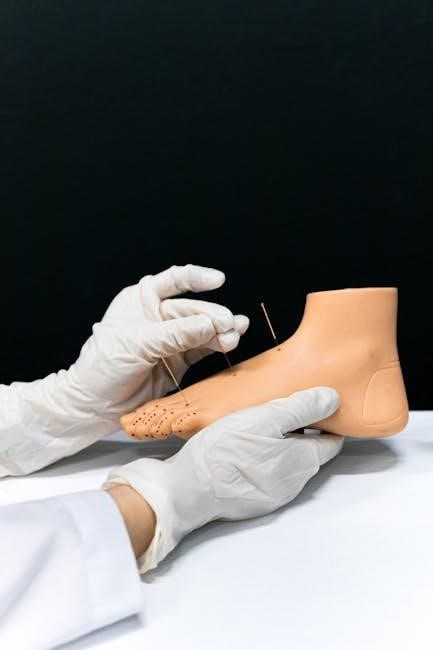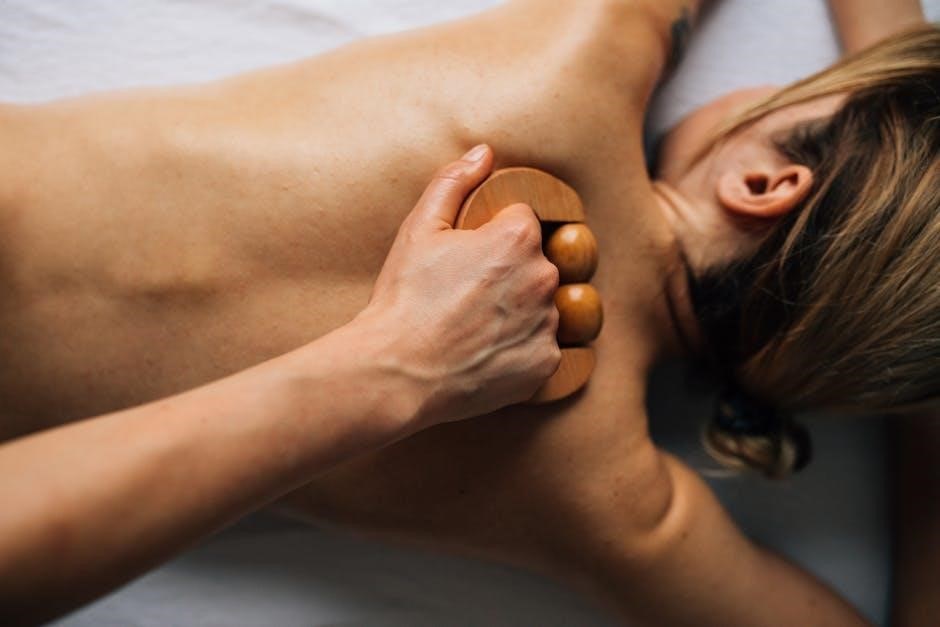Manual therapy is a clinical approach using skilled, hands-on methods to assess and treat soft tissues, joints, and the nervous system, emphasizing patient-clinician interaction.
1.1 Definition and Overview
Manual therapy encompasses a range of hands-on techniques used by healthcare professionals to diagnose and treat musculoskeletal and nervous system disorders. It involves skilled manipulation of soft tissues, joints, and other structures to restore mobility, reduce pain, and improve function. Techniques include massage, joint mobilization, and myofascial release, often tailored to individual patient needs. This approach emphasizes the therapeutic relationship between the clinician and patient, fostering active participation in the healing process. Manual therapy is widely recognized for its effectiveness in addressing various conditions, from chronic pain to postural imbalances, making it a cornerstone of physical therapy and rehabilitation practices worldwide.
1.2 Historical Background
Manual therapy traces its roots to ancient civilizations, with evidence of hands-on healing practices in Egyptian, Chinese, and Greek cultures. Hippocrates, often called the “father of medicine,” used joint manipulations to treat patients. In the late 19th and early 20th centuries, techniques like osteopathy and chiropractic emerged, emphasizing manual methods for structural and functional restoration. These practices laid the foundation for modern manual therapy, which has evolved to include a diverse array of techniques. The integration of scientific research and clinical experience has solidified its role in contemporary physical therapy, making it a cornerstone of rehabilitation and pain management globally.
1.3 Importance in Physical Therapy
Manual therapy is essential in physical therapy for its ability to address musculoskeletal and nervous system dysfunctions. By enhancing joint mobility, reducing soft tissue tension, and improving circulation, it alleviates pain and restores function. It fosters a collaborative environment, with active patient involvement enhancing recovery. Additionally, manual therapy complements other treatments, offering a holistic approach to care. Its effectiveness in improving mobility and reducing discomfort makes it a vital tool for physical therapists, aiding patients to achieve optimal outcomes and regain independence in daily activities. This hands-on approach remains central to modern rehabilitation practices.

Soft Tissue Techniques
Soft tissue techniques target muscles, tendons, and ligaments to improve flexibility, reduce pain, and promote healing through methods like massage and myofascial release.
2.1 Massage Therapy
Massage therapy involves the manipulation of soft tissues to relieve pain, reduce muscle tension, and improve circulation. Techniques like Swedish massage, deep tissue, and sports massage are commonly used to target specific areas, promoting relaxation and recovery. It is often applied to address chronic pain, inflammation, and restricted movement, enhancing overall well-being and physical function.
2.2 Trigger Point Therapy
Trigger point therapy targets hyperirritable spots within muscles, known as trigger points, which can cause localized pain and refer pain to other areas. Techniques like ischemic compression, stretching, and pressure applications are used to deactivate these points, reducing muscle tension and improving circulation. This therapy is particularly effective for addressing chronic pain, muscle spasms, and limited range of motion. By releasing tension in specific areas, it enhances mobility and alleviates discomfort, making it a valuable approach in treating conditions like fibromyalgia and sports injuries. Regular application can lead to long-term relief and improved functional movement patterns.
2.3 Myofascial Release
Myofascial release is a gentle, hands-on technique that targets the fascia, a connective tissue surrounding muscles, nerves, and organs. It aims to eliminate restrictions and tension within the fascial system, which can cause pain, stiffness, and limited movement. By applying sustained, gentle pressure, therapists help restore normal fascial mobility, improving circulation, reducing muscle spasms, and enhancing overall flexibility. This method is particularly effective for addressing chronic pain, sports injuries, and postural imbalances. Myofascial release promotes relaxation, reduces inflammation, and restores functional movement patterns, making it a versatile and beneficial approach in manual therapy practice.
Joint Mobilization Techniques
Joint mobilization techniques involve applying manual forces to improve joint mobility, reduce stiffness, and enhance movement. They are used to address pain, limited range of motion, and dysfunction.
3.1 Spinal Mobilization
Spinal mobilization techniques target the spine to restore movement, reduce stiffness, and alleviate pain. Techniques include gentle oscillations, sustained stretches, and specific joint manipulations. These methods enhance joint play, improving flexibility and posture, and are often used to address conditions like herniated discs or spinal stenosis.
3.2 Peripheral Joint Mobilization
Peripheral joint mobilization focuses on improving movement and function in joints outside the spine, such as the shoulders, knees, and elbows. Techniques involve graded oscillations or sustained stretches to enhance joint mobility, reduce stiffness, and alleviate pain. These methods are particularly effective for conditions like arthritis, post-surgical recovery, or sports injuries. By targeting specific joints, therapists can restore range of motion, improve joint lubrication, and reduce inflammation. The application of controlled force and speed ensures safety and effectiveness, making it a valuable tool in rehabilitation and maintenance of joint health.

Other Manual Therapy Techniques
This category includes specialized approaches such as craniosacral therapy and visceral manipulation, focusing on gentle, non-invasive techniques to enhance recovery and improve joint function.
4.1 Craniosacral Therapy
Craniosacral therapy (CST) is a gentle, non-invasive manual technique focusing on the cranium, spine, and sacrum. It involves subtle manipulations to improve cerebrospinal fluid flow and reduce tension in the dura mater. Practitioners use light touch to detect and release restrictions in the craniosacral system, promoting relaxation and self-correction. This therapy is often used to address headaches, chronic pain, and stress-related disorders. By enhancing the body’s natural healing mechanisms, CST can improve mobility, reduce inflammation, and restore balance to the central nervous system. Its benefits extend to emotional well-being, making it a versatile approach in manual therapy.
4.2 Visceral Manipulation
Visceral manipulation (VM) is a manual therapy technique that targets the internal organs and their surrounding fascia. It aims to improve organ mobility, reduce fascial restrictions, and enhance overall visceral function. Practitioners use gentle, specific manipulations to address dysfunctions in organs such as the liver, intestines, and pancreas. VM is often used to treat conditions like abdominal pain, digestive disorders, and chronic pelvic pain. By restoring normal movement and tension, VM can improve blood flow, reduce inflammation, and promote healing. This technique complements other manual therapies and is valued for its holistic approach to addressing both physical and functional imbalances within the body.

Benefits of Manual Therapy
Manual therapy offers pain relief, improves joint mobility, enhances recovery, reduces muscle tension, and promotes overall well-being by addressing soft tissue and joint dysfunctions effectively.
5.1 Pain Relief
Manual therapy is highly effective in alleviating pain by addressing the root causes of discomfort. Techniques such as joint mobilization and soft tissue methods target areas of restricted movement and tension, reducing inflammation and muscle spasms. By improving circulation and releasing endogenous opioids, these interventions provide both immediate and long-term pain relief. Patients often report a significant reduction in chronic and acute pain, which enhances their ability to perform daily activities. The hands-on approach also helps in breaking the pain cycle, allowing the body to heal more efficiently. This makes manual therapy a cornerstone in pain management, offering a non-invasive alternative to medications and surgeries.
5.2 Improved Mobility
Manual therapy significantly enhances mobility by addressing joint and soft tissue restrictions. Techniques such as joint mobilization and soft tissue methods target areas of limited movement, improving joint range of motion and muscle flexibility. By reducing stiffness and promoting optimal alignment, these interventions enable patients to perform everyday activities with greater ease. Enhanced mobility also supports rehabilitation, allowing individuals to recover faster and maintain an active lifestyle. The hands-on approach of manual therapy ensures tailored treatment, addressing specific mobility challenges and restoring functional movement patterns. This makes it an essential tool for improving overall physical function and quality of life, particularly for those with mobility impairments.
5.3 Enhanced Recovery
Manual therapy plays a crucial role in accelerating and enhancing the recovery process for individuals undergoing rehabilitation. By targeting specific areas of dysfunction, techniques such as joint mobilization and soft tissue methods promote optimal healing and tissue repair. These interventions improve blood flow, reduce inflammation, and break down scar tissue, fostering a conducive environment for recovery. Enhanced recovery also involves restoring normal movement patterns, which prevents long-term dysfunction and supports the body’s natural healing processes. This approach not only accelerates return to daily activities but also minimizes the risk of complications, making it an integral component of comprehensive rehabilitation programs focused on restoring full functional capacity.

Considerations and Precautions
Manual therapy requires skilled techniques and careful application to avoid adverse effects, emphasizing clinical reasoning to ensure safe and effective treatment tailored to individual patient needs.
6.1 Contraindications
Manual therapy techniques are not suitable for all conditions. Certain contraindications include acute injuries, fractures, severe osteoporosis, or recent surgeries, where manual techniques could exacerbate the condition. Additionally, areas with active inflammation or infection should be avoided to prevent further complications. Conditions like rheumatoid arthritis may require cautious approaches to avoid joint instability. Patients with a history of bleeding disorders or taking anticoagulant medications should be treated with extreme care to minimize the risk of internal bleeding. It is crucial for therapists to conduct thorough assessments and consider medical histories before applying any manual therapy techniques to ensure safe and effective treatment.
6.2 Safety Guidelines
To ensure safe practice, manual therapy techniques must be applied with careful consideration of patient-specific factors. Therapists should undergo proper training and maintain updated knowledge of evidence-based practices. Clear communication with patients is essential to obtain informed consent and address any concerns. Techniques should be modified to suit individual needs, avoiding excessive force or inappropriate methods. Proper sanitation and use of protective equipment are vital to prevent infections. Documentation of treatment plans and patient responses is crucial for accountability and continuity of care. Regular follow-ups and reassessments help monitor progress and adjust therapies as needed. Adhering to these guidelines minimizes risks and enhances therapeutic outcomes.
